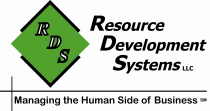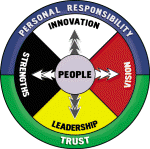Why our programs work

A New Approach Management, Leadership,
and Organizational Development.
While we were conducting our research we came across some
startling information --- Typical management and leadership
development programs do not have any impact on organizational
performance. With $170 Billion spent annually on
leadership development programs, the question begs to understand
why so many organizations have so few engaged employees and
perform in the realm of mediocrity. The answer is simple;
most leadership development programs are not designed to make a
difference.
Ours are designed to make a difference, and here are seven
reasons why they do:
The Seven Elements of High Performance™
It all begins with our highly researched
model of organizational performance dynamics. This simple, yet
comprehensive and powerful model provides information on why
exceptional organizations achieve better results, explains
complex concepts, such as organizational culture and employee
engagement, and gives you a road map on how to use these
elements to create your own high performance organization.
While there are many sub-models, some of the more
important ones that really help our programs make an impact are:
-
Whole Person
Dynamics™ – If we are to put People at the Center then
this model helps managers to better understand some of the
dynamics that are at the heart of people.
-
Management Dynamics™
– There is a lot of discussion about the dichotomy of
management and leadership, yet little of it is actually
founded in research.
This model demonstrates that Leadership is actually a
subset, or role, of being a Manager, and then shares what,
based on where in the organization a manager is, what they
should be their primary role and where they should be
placing their attentions.
-
The Diamond of
Engaged Performance™ – The research is clear; engaged
employees are critical for organizational performance.
Yet, it isn’t so clear about what employee engagement
actually is, or what creates it.
Too many organizations, vendors, and consultants are
focusing on making employees happy, but that is so far away
from what engagement is, there is no wonder most
organizations are still mediocre.
This model spells out the four Elements that combine
together that energize and focus employees on the things
that are essential for organizational performance.
You can learn
more about this research here
read more
Most leadership and management
development programs begin with the idea that if they simply
develop the individual into a better manager or leader, then
that will translate into better performance.
And while the manager’s individual performance may
increase, it doesn’t mean that this increase in performance will
translate into increased team or organizational performance.
Our basic tenant is that it does take exceptional leaders
to create exceptional organizations, but the focus must be on
the development of the organization and not the individual.
While participants in our programs certainly learn and
are challenged to better themselves, we keep them focused at all
times on how to apply that learning to their teams and the
organization.
Modularization – It takes time to change
Our programs are designed to be delivered
over time. You
simply cannot develop a manager into a leader, whether at the
line supervisory level, or at the executive level, in a program
over 5 consecutive days.
That is entirely too much information being delivered at
one time, and then there is no support system in place for the
application of that learning back at the worksite.
But our programs are designed to be delivered in one or
two day sessions, where managers learn concepts, master skills,
and then are given time to apply them back on the worksite
before we move on to the next set of concepts.
Hands-on Learning
Our workshops are not a series of
lectures. Instead,
we offer new concepts succinctly through demonstrations or
videos, and then move the participants into individual
reflection, group discussions, and then class discussions.
Skills are then practiced, and action plans are
developed. Our
workshops are never passive, and everyone gets a chance to
participate. Every
group discussion is led by a “table leader,” who then provides a
“report” back to the rest of the class on what was discussed.
In addition to teaching and applying leadership skills on
this small level, it also helps managers to feel more
comfortable organizing information and then presenting it to
their peers on the fly.
Application Exercises
Yes, we assign homework!
At the end of every session there are activities that are
assigned that are specifically designed to help put into action
what the participants have been learning during that session.
The whole purpose of chunking information into smaller
modules is to allow for the application of that information.
After all, learning how to be a better leader does not
happen in the classroom, but back at the worksite, where
managers interact with those that they lead.
Teambuilding
Teams and
teamwork is the most untapped business advantage today.
Because our programs are designed to get managers
interacting with those they lead, they begin to Build Trust and
teamwork. This
develops not only the manager but also their team, and turns
learning into action which then leads to results.
Impact Project™
All of our programs are designed to
impact the overall performance of the organization, whether it
is through the increase of employee engagement and the
organization’s Payroll Efficiency Factor™, which is the focus of
our
Leadership Connections:
Engaging Performance™ program, or the development and
implementation of what we call an Impact Project™, which is a
major component of all of our executive leadership programs,
including
TeamQuest™ and
the
Executive Leadership
Forum.
Impact Projects™ are intended to allow a team to identify an
Impact Goal™ that when achieved within the next 6 months will
have a major impact on the organization’s performance.
The idea is not for any one manager to
identify and achieve that goal, but rather, the manager will
lead their team through the identification and planning process,
and then support their team as the team implements and puts that
plan into action.
Some Impact Projects™ simply solve minor issues that are causing
major aggravation for employees or customers, while others
tackle more major issues.
For example, one client’s Impact Project™
from their
TeamQuest™
program cut over $1.6 million per year in scrap and waste, which
was 1.6% of revenue and a huge impact on their bottom line
profits. Their
Leadership Connections:
Engaging Performance™ program saw an increase in their
employee engagement, as demonstrated by an increase of 10% in
their Payroll Efficiency Factor™, and a drop in their turnover
rate by two-thirds.
To
Learn more about this Client's Outcome, Click Here
Contact Us to Learn More About
How You Can Bring Our Programs to Your Organization to Get
Results!


